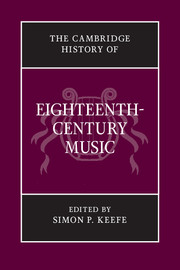Book contents
7 - Listening, thinking and writing
from INTERLUDE
Published online by Cambridge University Press: 28 March 2011
Summary
The emergence of new audiences in the eighteenth century spawned different ways of thinking about music, resulting in modes of writing not evident in the previous century. Some of the traditional audiences, of course, remained intact, such as those for liturgical music and opera, as did the venues provided by wealthy patrons, but over the course of the century one no longer necessarily had to go to a church to hear religious music or be invited to a court to hear operas or symphonies. Concert societies and organizations sprang up across the Continent and in Britain that in some cases engaged listeners other than aristocrats, running on either a profit or a non-profit basis. In part, the new audience arose from a new breed of music-makers, both amateurs and connoisseurs, women who played keyboard instruments, and others who could play chamber music, solo pieces, or the orchestral repertory.
With audiences now larger and more numerous than they had been, embracing musically sophisticated listeners as well as those with less developed tastes and coming from a much broader social spectrum (although still primarily from the upper classes), those who wrote about music often considered themselves on a special mission. Along with a burgeoning listening audience came a similar explosion in the numbers prepared to read about music, and writers on the subject could therefore write with the assurance that their thoughts would reach a significantly sized readership.
- Type
- Chapter
- Information
- The Cambridge History of Eighteenth-Century Music , pp. 181 - 200Publisher: Cambridge University PressPrint publication year: 2009
References
- 12
- Cited by



